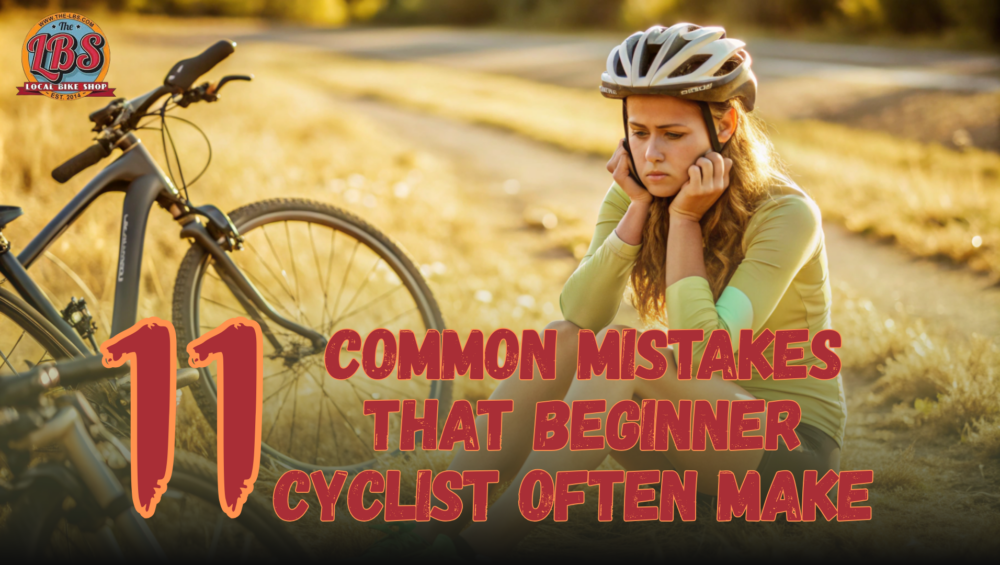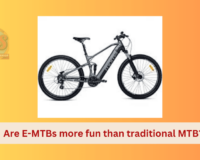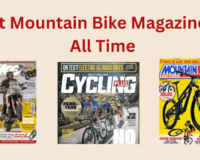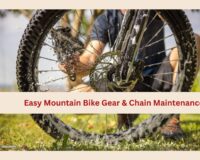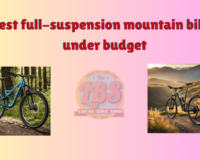The one biggest “error” or blunder with newbies is their lack of understanding of the bike’s needs and geometry. They need to learn and develop a new cycling routine before they fit in- not to hurt their back or neck.
Individuals who cycle more than once a week for extended periods are more susceptible to discomfort and overuse injuries without proper adjustments. It can be a mix of excuses and the initial thrill of being free outdoors.
Not all are good at it; with thorough practice, we can be good at it. As they say, “Experience is a good teacher; you learn by doing.” To make the beginner riding course easy, our job is to point out and help the starters acquire “what it takes” to master the ride.
1. Ignoring bike fit and saddle height
It’s an easy and common mistake for one to make regarding the bike fit and saddle height. Each bike has a key feature and a demand that one need not ignore. For example, relaxed stand-up bikes require upright handlebars and wider tires. That is to reduce strain on the back, as one of the users on Reddit added,
“Well, the reality is that they should be on a more relaxed bike. It’s one thing to hold your position for 20 minutes on the smart bike or your bike after it’s set up in an aggressive position and another one to hold it on a morning.”
Another user on Quora adds, “Especially from a health or even public health point of view, bike fits are also a form of upstream preventive care.” Knowing about your tools, accessories, bikes, saddle posts, and every minute detail of the ride is the first step to achieving a result. You don’t have to overtrain to get things right, things do not work this way.
2. Overexerting road biking too soon
The beginning cyclist often miscalculates on how to start and how to take control of their ride. In turn, they make silly mistakes that overexert them and cause them to have persistent fatigue and unusual heart rates. With the LBS, you get durable and high-end mountain frames; scroll your favorite.
These symptoms indicate that the body is not recovering adequately from the training stress. It is because they lack proper posture. Keep your shoulders relaxed and pull back; don’t lean forward; keep your back straight; hunching over won’t give you progress. You set a proper seat height and equilibrium distance for handlebar prey to achieve that.

New cyclists don’t have this physical fitness and cannot gauge and understand the limits. Either they overdo or underdo, but technically, even the simplest ride can be overexerting for them. They need time before they actually develop their warm-up schedules and then focus on intense cycling.
Don’t be overambitious; give your body a rest. If novice cyclists don’t learn these mistakes early, they will ignore signs of fatigue and end up with only pain.
3. Neglecting Basic Bike Maintenance
You know how it goes sometimes; even the best of us can get a little neglectful when it comes to bike maintenance. However, neglecting things like worn brakes and loose components can lead to some serious and unexpected trouble.
Regular maintenance, even the basics, can prevent wear and tear and certain mishaps down the line. So, don’t just be ignorant; when your bike needs some TLC, it will show symptoms before a grumpy ride!”
i) Keep those tires pumped up
Proper tire pressure is crucial for handling and protection. We need to keep them inflated. A pre-ride inspection is what someone new to cycling can miss out on. There are security hazards, potential bike crashes, the low performance of the tires, and many others. Get your Wheels Manufacturing Essential Kit – Bearing Drift today!
ii) Clean up after a muddy ride caused by road cycling
Excess dirt and grime can wear down your bike’s components. For your bikes to last longer, you need to clean your bike from riding in extra-wet or muddy conditions. Give it a good wash after riding in wet or muddy conditions.
iii) Lubricate regularly
Timely lubrication cannot be missed. A well-lubricated bike becomes smoother and runs more efficiently. Don’t forget to lube your chain, derailleurs, and other moving parts. On top of that, when not in use, store your bike in a dry and sheltered area to prevent any erosion of its parts.
iv) Check for signs of wear; especially as a beginning cyclist
Pay attention to any unusual noises or vibrations your bike makes. A well-maintained bike is what is required for bikers so that their risk of injury is addressed. Brake issues, tire wear, unusual noises, and shifter problems could be signs of a problem that needs our immediate attention. Get yours ENVE Composites Brake Pads for smooth ride as a toddler.
v) Carry essential tools
A good bike pump, replacement cables, and a basic toolkit can help you fix minor issues on the trail. Always pay attention to the sound of the bike, as it can help you know any signs of problems and fix them eventually. Get your Feedback Sports Team Edition Tool Kit today.
4. Skipping Safety Gear
Protection alternatives can be in all forms; this can prevent injuries and also help to ride comfortably in all light conditions, like dawn dusk, or even in poor weather. You have eyewear and headwear for your head, and the repair tool kit will help you be of some use and rather not be stranded without help.
Always wear a helmet; this is non-negotiable. And we use this light and reflective clothing and headlights to see and be visible to others on the biking trails.
5. Riding road bikes with Flat tires
When the tires flat out, we change it immediately or pump it up as necessary. If not, be ready for the consequences. This can bottom out on bumps, damage the tires, inner tube, and rims, and in turn, the cost of repair goes high.
Experts can easily check on soft tires and prevent mishappening on the trail. Ignorance is not bliss, not when you are not aware of the tire conditions or you ignore a gradual deflation. It only becomes critical, so be prepared for the repair instead, and stay tuned with us to keep more information on flat tires, how to fix them, and watch out for visible damage to your bike.
For fixing a small puncture, all you need is tire plugs, an insertion needle, rubber cement, and a reaming tool. When it is more than that, you need a hand pump, CO2 inflator, and battery-operated air compressor that can inflate your tire by plugging it simply everywhere you need it.

There are these tire pressure gauges that can help you check if the tires are properly inflated or not. We also have these tire levers, which help remove the inner tube of the tire from the rim and inspect the damage. Jacks, pliers, lug wrenches—we all need this to start the tire process—lift, remove nails, or even round up the lug nuts in the whole process.
6. Misusing Bike Gears
Shifting a bike at the wrong time is a mistake that can lead to several other issues like mechanical strain, loss of momentum, and many more.
Don’t pedal still; every first-time user struggles with this and sometimes pedals backward when they require a forward motion. There are wellbeing concerns you cannot ignore.
Usually, people don’t bother to check the cables; it’s common for one to ignore the tension there and sometimes overlook how corroded or stiff they have become. Lubricating them can only make your bike handling better.
i) Insufficient knowledge of gear ratios
Not understanding the ratios can accidentally lead you to extreme combinations that result in misalignment. The consequence is increased wear and tear with extreme angle exchange and pre-mature failure of bike components.
You know what possibly can go wrong here: the additional friction and inefficient power transfer. If you get stuck with shifting issues, your chain may accidentally slip or break.
ii) Failing as a cyclist to ease up while shifting gears
Shifting gears under load is something initial users fail at. Initial bikers make certain forcing shifts without easing off or not giving the derailleur their time to adjust.
When a cyclist does that obviously without the whole idea, faces difficulty in climbing hills and also has a loss of control. They need to practice shifting techniques, take control, and not just overlook everything.
7. Failing to Refuel
Before each ride, make sure you have eaten porridge, bananas, toast, or something else you like. A couple of bottles and sandwiches all provide you with the energy you need to fight for your ride.
Toddlers ignore hunger signals as they have adequate planning breaks or are unaware of ride intensity and duration. The energy might crash before the bike. It’s always the best idea to have energy gels, chewy snacks, bananas, dried fruits, and protein bars on your ride as your snacks to refuel yourself from time to time.
8. Poor Cornering Technique
What if I say this mistake can cost you your safety? Poor cornering is an inability on your part; it’s common, but as a cyclist, you have to evolve and adapt to the correct body position in different forms of riding.
For cornering, it has to be riding in drops, handling turns, and a lower center of gravity. A cornering requires the biker to keep their outside foot down and their inside foot up. A balance trick is all that is needed for your stable cornering ride.

Initial learners do not always know that cornering also needs their attention on the choices of line. One needs to enter wide, lean into the apex, and then only exit wide for the traction, speed, and control in corners.
But before they have to focus on any obstacles on the centerline. Don’t just brake in the turn in the middle; this can lead you to injury and even destabilize your position.
9. Wrong Biking Clothing
Wearing underwear underneath your cycling shorts is a big no-no. You may unclip and fall flat on the face if you make this mistake. As someone new, you are unaware of the basics of what suits your ride, and that is where the real trouble starts. You must have adequate knowledge regarding the essentials, including cycling clothes, cycling shoes, and a proper bike helmet.
Single-cycle mistakes under the sun, This can be weird; you take your underwear off. The chamois padding on your shorts makes sitting on the saddle a lot more comfortable. This can be a quick alternative that will just make your ride, as a learner, more convenient. It’s a habit to unlearn to wear your undies.
Wearing a windproof cape will prevent wind chill and keep body heat. Sleeve jerseys, thermal base layers, and waterproof fabrics can be a good choice for you as the base layers. When it’s cold outside, you can have an insulated jacket.
10. Not enough attention to their bike and protection equipment
Be free and notice your motion; if you fall in slow motion on your cycling journey, this could be something possibly wrong. This is because you are ignoring protection equipment or because your bike is not the right one for you to go along in long miles of tract, you know.
If you wonder what the safety equipment is gear from helmets and gloves to high-quality reflective clothing you wear—it is all of that that keeps you safe from the risk of injuries. Get into the habit of regularly checking and keeping your bike in perfect shape.
No spare parts, no mercy; no one will be there to help you on the trail. You need to carry your own: what if your tires get punctured—a double puncture— and things fall apart? Novice bikers often overlook the need for inner tubes, gas canisters, or mini pumps on their first ride. Only after certain bumps on the road do they realize the need to fight these punctures on their own. This can only make life easier for beginner cyclists.
11. Often skip out on Road Rules
As a toddler rider, you are not used to road rules, road bikes, and long rides. New riders forget the basic rules of road riding, like simply giving hand signals for turning and stopping. They may not always use front and rear lights at reasonable distances and have much awareness of traffic. To advance on their road biking, they can join cycling clubs, go for group rides and longer rides, and grab as much of cycling tips available, as possible.
Conclusion
Shop for all your cycling needs at your local bike shop! We offer a wide selection of products from top brands like Hope, All-City, Avid, Bolle, Cult, Hayes, Jagwire, and more. From components and tools to frames and custom bikes, we got you covered. Stay tuned for more information!
FAQs
1. How do I stay safe, as a new cyclist, when cycling in heavy traffic?
“Avoid the door zone” is as easy as it sounds; you need to keep a safe distance (at least 0.5 meters) from others when riding or parking the vehicles. Continuously, you need to look for troubles in surroundings like potholes and debris and communicate turns or stops to other road users.
Stay alert to pedestrians who come stepping into your path. Also, one needs to look for blind spots in long vehicles and not make the mistake of riding up inside long vehicles. The safest way is to keep your hands on the bike, avoid distractions, and never ride your bike after you drink.
Before a tram or train rail, cross the rails at a 45-degree angle; slow down, and your wheels won’t get stuck. Look ahead and ride in the middle of the lane for a less miserable riding experience in heavy traffic.
2. How can I stabilize, as a beginner, my bike while cornering?
Simply keep in mind, “Brake before the turn and avoid sharp braking during the turn.” Balance your weight, choose the right line, use the correct hand and foot positions, and adjust for road conditions, and all you have to do is believe in yourself.
Ride in the drops; it’s like you holding onto the steering but lowering down. We lean our body to the pedal on the outside turn when cornering. At that time we need to bend our knees and elbows and keep the wheels running straight and parallel; this can stabilize your bike.
3. How can beginners prepare for hill climbing?
Climbing hills isn’t easy for starters. They hesitate to go up gradually for mountain biking and start sprinting right away, which is a mistake. The first thing to do is know the tactics, start “slow and steady,” and experiment with a lower gear to get that “perfect cadence” for uphill climbing. A good and supportive mountain bike, or a professional bike, could be of great help in situations like this.
However, that does not mean new riders should not do breath training. Sometimes, avoiding that minimalistic tension in your muscles can simply do the job for you.
4. What are some general tips for beginners to become a cyclist?
“Before you even get on the bike, check tire pressure, shock pressure or preload, and handlebar alignment,“ Marcus Mitchell, an intermediate rider, suggests to his aspirant friends. The only thing complex is a suspension fork; take a chance to learn and get help if you are a newcomer.
5. Which crankset is suitable for beginners?
Double cranksets are more reliable and versatile for beginners. For fixed gear and track bikes, the Sugino 75 Track Crank Arm Set and Hope Evo Crankset are suitable. Budget options include Miche Primato and SRAM S300, which can be a classic design with good value for the price.
6. What safety gear is essential for new cyclists?
Starting with a mandatory bike helmet and other gear like goggles, cycling gloves, lights, reflectors, mirrors, knee pads, and elbow pads prevents you from the risk of crashes or injuries. A bell or horn, rearview cameras, phone, map, bike lock, first aid, and bike repair kit are all it needs for a better experience for new cyclists.

